Monitoring little brown bat (Myotis lucifugus) maternity colonies: understanding populations in advance of White Nose Syndrome
Little brown bat populations in eastern North America have been ravaged by a new disease called White Nose Syndrome. This disease has caused the death of millions of bats in the East and bat biologists in the West are struggling to understand what this means for western bat populations. To gain a better understanding of population dynamics of little brown bats in Colorado, CNHP and Colorado Parks and Wildlife have partnered to monitor several large maternity colonies in northern Colorado. CNHP has marked female and young bats at two ranches, The Nature Conservancy’s Carpenter Ranch and The Yampa Valley Land Trust’s Rehder Ranch, and are using PIT-tag reading antennas to document when and how many bats return. These data will be used in mark-recapture analyses to assess survival and population persistence.

Since 2014, we have marked ~2,000 little brown bats, with some individuals spending a majority of their time at one roost. Many of these individuals are adult females that are birthing and raising young. In the late June and early July, peak daily detections of these marked individuals can exceed 150 individuals.

One individual has been documented using the roosts for 119 days over the 2.5 years.